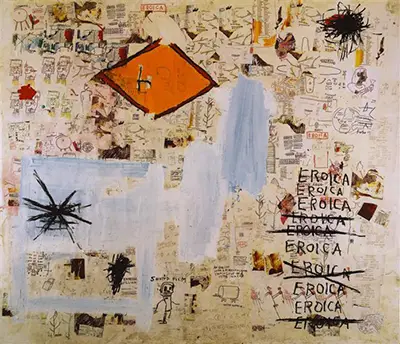Within this version is a large orange rectangle, angled onto its point, with a dark outline. This initially captures our focus. There are then ten repetitions of the word Eroica in capital letters to the right hand side. Some of these are crossed out, seemingly at random. Basquiat would regularly use text within his paintings in order to allow a greater meaning within some of his wild strokes of line and colour. It also offered him the chance to bring in specific events from history, such as particular wars, invasions or individual people without having to change his abstract style. He also would cross out some of these words sometimes, or instead use them to label other parts of his work. Much of it would still leave us confused and experts on the artist are essential in order to fully understand this highly complex and expressive mind who frequently left us clues within his work, but these often still need explaining. Alongside this piece, there was also Eroica I and II.
Basquiat's message within this painting is that death overcomes heroism, essentially as demonstrated by the loss of his close friend, Andy Warhol. The artist was now concerned about his own mortality and was expressing his fears within this painting. Some of the scribbles found across this series of artworks refer to bullet holes and other symbols of death which continued to impact his mindsight as he grieved for his friend.
Basquiat tackled the theme of death within this piece and it is a topic that looms large in many artist's careers. Depression and other mental health issues are common within the artistic community and this can lead to a concentration of relatively negative subjects such as this. Basquiat though also spread across many other themes within his work, often delving deep into history and social issues with textual content that sat alongside his memorable figurative portraits and flashes of line and colour. We remember him most for his defence of the Afro-Caribbean community, a group who had not previously received much attention from western artists because most were not from this background. Basquiat led the charge for black artists to achieve far more recognition, and today we are starting to see the fruits of his labour, though at a relatively slow pace of progression.


